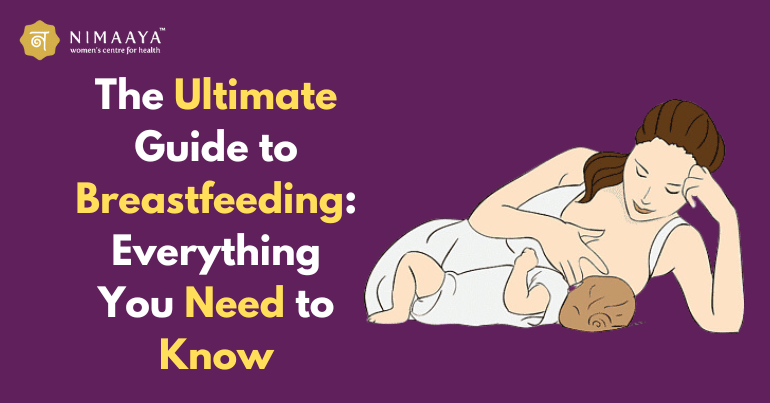Introduction
Breastfeeding is more than just a way to feed your baby; it’s a profound bonding experience that offers numerous benefits for both mother and child. Navigating through the journey of feeding breasts can be both rewarding and challenging. From mastering breastfeeding positions to understanding the importance of Breastfeeding Nutrition, this ultimate guide aims to equip you with all the essential knowledge and tips you need to embark on this beautiful journey confidently.
Importance of Breastfeeding
Breastfeeding is not just a biological function; it’s a cornerstone of maternal and infant health with profound implications for both. Beyond providing optimal nutrition tailored to a baby’s needs, breast nurturing offers a myriad of benefits. It bolsters the immune system, shielding infants from infections and diseases, while fostering emotional bonding between mother and child.
Breast milk contains antibodies and enzymes that cannot be replicated, offering unmatched protection against illnesses. Moreover, breast nurturing promotes healthy weight gain, lowers the risk of chronic conditions such as diabetes and obesity, and even enhances cognitive development. For mothers, it aids in postpartum recovery, reduces the risk of certain cancers, and strengthens the maternal-infant bond. In essence, breast nurturing is a vital investment in the long-term health and well-being of both mother and baby.
Benefits of Breastfeeding for Both Mother and Baby

Feeding breasts provides unparalleled Breastfeeding Nutrition for infants, offering the perfect blend of vitamins, protein, and fat crucial for their growth and development. It also bolsters the baby’s immune system, reducing the risk of infections and diseases. For mothers, breast nurturing promotes faster postpartum recovery, helps in weight loss, and reduces the risk of certain cancers. The emotional bond formed during feeding breast strengthens the mother-baby relationship, fostering a sense of security and comfort for both.
‣ Enhanced Immune System:
Breast milk is rich in antibodies, enzymes, and white blood cells that bolster the baby’s immune system, offering protection against various illnesses, including respiratory infections, ear infections, and gastrointestinal issues. This natural immunity is crucial, especially during the early stages of infancy when the baby’s immune system is still developing.
‣ Optimal Growth and Development:
Breast milk provides the perfect balance of nutrients, including proteins, fats, carbohydrates, and vitamins, tailored to meet the nutritional needs of the growing infant. It supports healthy brain development, vision, and overall physical growth, laying a foundation for lifelong health and well-being.
‣ Reduced Risk of Chronic Diseases:
Babies who are breastfed have a lower risk of developing chronic conditions later in life, such as obesity, type 2 diabetes, asthma, and certain allergies. The protective effects of breast nurturing extend into adulthood, promoting better health outcomes in the long run.
‣ Postpartum Recovery for Mothers:
Oxytocin is a hormone that helps the uterus contract, minimising postpartum haemorrhage and promoting the mother’s recovery after childbirth. It is released when a baby is breastfed. Additionally, feeding breasts promotes the return to pre-pregnancy weight by burning extra calories, contributing to maternal health and well-being.
‣ Emotional Bonding and Security:
The act of this beauty fosters a deep emotional bond between mother and baby, creating a sense of security and comfort for both. The close physical contact and eye contact during breast nurturing promote feelings of intimacy and attachment, strengthening the mother-baby relationship.
‣ Convenience and Cost Savings:
Breast milk is readily available and requires no preparation, making this convenient for mothers, especially during nighttime feedings. Moreover, breast nurturing is cost-effective compared to formula feeding, saving families significant expenses on infant formula, bottles, and sterilization equipment.
Feeding breast offers a multitude of benefits of breastfeeding for both mother and baby, ranging from optimal nutrition and enhanced immunity to emotional bonding and cost savings. It is a natural and invaluable gift that supports the health and well-being of families worldwide.
Also Read: Discover the Top 5 IVF Centers in Ahmedabad for IVF Journey
How to Prepare for Breastfeeding During Pregnancy
During pregnancy, it’s essential to prepare for feeding breasts by educating yourself about its nuances. Attend prenatal classes that offer guidance on breast nurturing techniques and seek advice from lactation consultants. Invest in comfortable nursing bras and consider purchasing a breast pump for expressing milk if needed. Surround yourself with a supportive network of family and friends who can offer encouragement and assistance along the way. During pregnancy, it’s essential to prepare for breast nurturing by educating yourself about its nuances. Here are four essential ideas to think about:
• Attend Prenatal Classes:
Enrolling in prenatal classes dedicated to feeding breasts can provide invaluable insights into the mechanics of nursing, proper latch techniques, and troubleshooting common Breastfeeding Challenges. These classes often offer demonstrations and interactive sessions, empowering expectant mothers with the knowledge and confidence needed for successful breast nurturing.
• Seek Lactation Consultant Guidance:
Consulting with a lactation consultant can be immensely beneficial, especially if you anticipate challenges or have specific concerns about breast nurturing. These professionals offer personalized guidance and support, addressing individual needs and providing practical solutions to common issues such as latching difficulties or nipple pain. They can also offer advice on pumping and storing breast milk, preparing you for various scenarios once your baby arrives.
• Invest in Nursing Essentials:
As you prepare for chest-feeding, invest in comfortable nursing bras and tops designed to facilitate easy access for nursing sessions. Consider purchasing a quality breast pump, even if you don’t plan to exclusively pump, as it can be invaluable for maintaining milk supply, relieving engorgement, or allowing your partner to participate in feeding. Having these essentials on hand ensures you’re equipped to navigate the breast-nurturing journey with ease and comfort.
• Build a Supportive Network:
Surround yourself with a supportive network of family and friends who understand and respect your decision to breastfeed. Having a support system in place can make a world of difference, whether it’s receiving encouragement during challenging moments or having someone to lend a helping hand with household tasks while you focus on bonding with your baby. Communicate your needs and preferences with your support network, fostering an environment of understanding and assistance as you embark on your breast-nurturing journey.
Common Challenges and Solutions for Breastfeeding

While this is natural, it can come with its share of Breastfeeding Challenges. From sore nipples to difficulty with latching, many mothers encounter hurdles in this journey. Engage the services of a lactation consultant or seek guidance from experienced mothers to overcome these obstacles. Utilize nipple creams to soothe soreness and experiment with different breast nurturing positions to find what works best for you and your baby.
① Low Milk Supply:
One of the most common concerns among breastfeeding mothers is low milk supply. This can occur due to various factors such as inadequate latch, infrequent feedings, or certain medical conditions. To address this challenge, ensure proper latch and frequent nursing sessions to stimulate milk production. Additionally, consider incorporating galactagogues like fenugreek or lactation teas into your diet to boost your milk supply naturally. Consulting with a lactation specialist can provide personalized strategies to enhance milk production and ensure your baby receives adequate nourishment.
② Engorgement:
Engorgement, characterized by swollen, tender breasts due to an abundance of milk, is another challenge faced by these mothers, especially in the early postpartum period. To alleviate discomfort, apply warm compresses or take a warm shower before nursing to encourage milk flow. Massaging the breasts gently can also help relieve engorgement. Furthermore, expressing a small amount of milk by hand or with a breast pump can soften the breast and facilitate easier latching for your baby.
③ Latch Issues:
Achieving a proper latch is crucial for effective breast nurturing, yet many mothers struggle with this aspect. Poor latch can lead to sore nipples, inadequate milk transfer, and frustration for both mother and baby. Seek assistance from a lactation consultant or breast nurturing support group to improve the latch technique. Techniques such as ensuring a wide mouth opening, aiming the nipple towards the roof of the baby’s mouth, and supporting the breast properly can aid in achieving a comfortable and effective latch.
④ Breastfeeding in Public:
Many mothers feel apprehensive about this act in public due to social stigma or discomfort. However, with support and preparation, breast nurturing in public can become more manageable. Invest in nursing-friendly clothing or nursing covers for added privacy if desired. Practice this act in front of a mirror at home to gain confidence in your technique and discreetness. Remember, this is a natural and protected right for mothers and babies, and advocating for your needs and those of your child is essential.
Also Read: Exploring the Top 5 IVF Centers in Surat for Successful IVF Journey
Breastfeeding Positions and Techniques

Mastering various breastfeeding positions is crucial for ensuring both comfort and efficiency. Experiment with positions such as the cradle hold, football hold, and side-lying position to find the one that suits you and your baby’s preferences. Each position offers unique benefits; for example, the football hold may be particularly helpful for mothers with larger breasts or those recovering from a cesarean birth.
Ensure proper latch-on technique by bringing the baby close to your breast with their mouth wide open. Aim for a deep latch, ensuring that the baby’s lips are flanged outwards like fish lips. This helps prevent nipple pain and ensures efficient milk transfer.
Additionally, consider using breast nurturing pillows or cushions to support your baby’s weight and alleviate strain on your arms and back. These aids can make this act more comfortable, especially during extended feeding sessions.
Lastly, don’t hesitate to seek assistance from a lactation consultant or support group if you encounter difficulties. They can offer personalized guidance and troubleshooting tips to help you overcome any challenges and make this journey a rewarding experience for both you and your baby. Remember, patience and practice are key to perfecting breastfeeding techniques.
Nutrition and Diet Chart for Breastfeeding Mother

Maintaining a healthy breastfeeding diet is essential for these mothers to ensure optimal milk production and quality. Make and consume a breastfeeding diet chart rich in fruits, vegetables, lean proteins, and whole grains. Stay hydrated by drinking plenty of water throughout the day. Incorporate breast-nurturing-friendly foods such as oats, fenugreek, and leafy greens into your meals. Avoid excessive caffeine and alcohol consumption, as they can affect milk supply and quality.
Also Read: The Importance of Prenatal Care: Nurturing a Healthy Pregnancy
Pumping and Storing Breast Milk

Breast pumps offer flexibility for mothers who need to express milk for various reasons. Invest in a high-quality breast pump and familiarize yourself with its usage. Establish a pumping routine that aligns with your baby’s feeding schedule to maintain a steady milk supply. Properly store expressed breast milk in clean, labeled containers in the refrigerator or freezer. Follow guidelines for safe thawing and reheating to preserve the nutritional integrity of the milk.
Tips and Advice for Breastfeeding in Public
Doing this in public can feel daunting for many mothers, but it’s a natural and legal right. Plan by dressing in breast-nurturing friendly attire or using a nursing cover for added privacy. Familiarize yourself with your rights regarding breast nurturing in public spaces to feel empowered and confident.
Remember, your baby’s needs come first, so prioritize their feeding comfort regardless of your surroundings. When it comes to feeding breast in public, preparation and confidence are key. Here are some essential tips and advice to help make feeding breasts in public a positive experience:
❧ Choose Breastfeeding-Friendly Attire:
Opt for clothing that allows easy access for nursing, such as tops with discreet nursing openings or button-down shirts. This ensures that you can breastfeed comfortably and discreetly without drawing unwanted attention.
❧ Utilize Nursing Covers or Scarves:
If you prefer added privacy while feeding breasts in public, consider using a nursing cover or scarf. These accessories provide a level of discretion and allow you to nurse with confidence, even in busy or crowded settings. Experiment with different styles to find what works best for you and your baby.
❧ Know Your Rights:
Familiarize yourself with the laws and regulations regarding feeding breasts in public spaces. In many places, it is not only socially acceptable but also legally protected for mothers to breastfeed their babies wherever they are allowed to be. Knowing your rights can help you feel more empowered and confident when nursing in public, allowing you to focus on your baby’s needs without worrying about judgment or interference.
By following these tips and embracing your right to breastfeed in public, you can nourish your baby with confidence and ease, no matter where you are. Remember, feeding breasts is a natural and beautiful act that should be celebrated and supported, regardless of the setting.
Also Read: Filtering the Top 5 IVF Centers in Vadodara for Successful IVF Journey
Weaning from Breastfeeding
Weaning is a gradual process that marks the transition from feeding breast to other forms of nutrition. Introduce solid foods gradually as your baby approaches six months of age while continuing to breastfeed or offer formula. Follow your baby’s cues and gradually reduce breast nurturing sessions over time. Be patient and supportive during this transition, offering comfort and reassurance as your little one adapts to new feeding routines.
Conclusion:-
In conclusion, breastfeeding is a remarkable journey filled with love, nourishment, and bonding. By arming yourself with knowledge about breast nurturing positions, nutrition, and common challenges, you can embark on this journey confidently. Remember to prioritize self-care and seek support when needed, whether it’s from lactation consultants, family, or online communities. Embrace the beauty of breastfeeding and cherish the special moments it brings for you and your baby.
For those seeking expert guidance and support on their breast-feeding journey, consider consulting with the Best Gynecologist in Surat or exploring resources provided by the Nimaaya IVF Center. With the right knowledge and support system in place, you can navigate through any challenges and enjoy the countless joys that breast nurturing has to offer.

